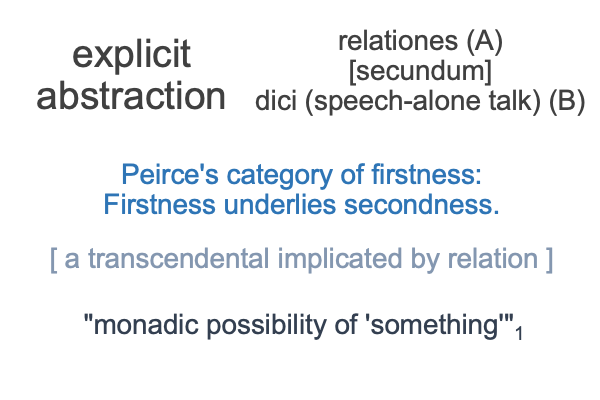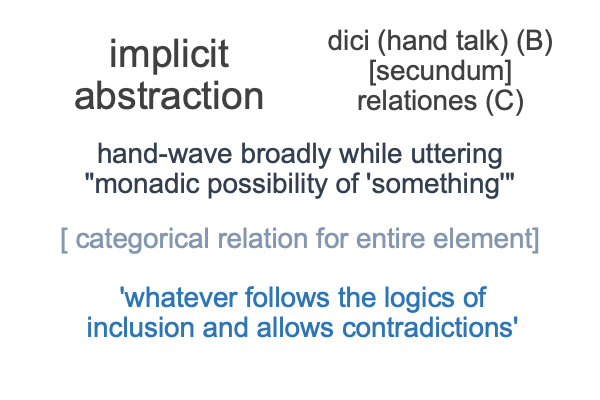0119 The conceptual-flow apparatus of A,B,&C also applies to Peirce’s category of firstness as explicit matter (A).

0120 An explicit definition of firstness (B) stands as form in the dicey bucket, then as matter in the esse bucket.
In the esse bucket, dici (speech-alone talk acting as hand-talk) relates to whatever follows the logics of inclusion and allows contradictions.

0121 Rather than giving another example, I proceed to section four, where the author formulates how we should understand relationes secundum dici.
Since this examination is already disruptive, let me proceed to some suggestions that sort of correspond to the author’s points and some that do not.
0122 First, let go of the distinction between categorical and transcendental. Even though the distinction is helpful, it does not appear to be critical to the speculations at hand.
0123 Second, all dici relations have two termini, the relation itself (portrayed as a hylomorphic dyad consistent with Peirce’s definition of secondness) and the elements that go into the relation (for Aristotle’s hylomorphe, “matter” and “form”, and for the dici relation, “dici” and “relationes“).
0124 Third, as soon as relationes secundum X (where X = esse or dici) is formulated as a dyad in the realm of actuality, the relation is subject to the laws of contradiction and noncontradiction. The label for the contiguity is placed within brackets for clear notation. The contiguity’s label is selected on the basis that [it] minimizes contradictions between the two real elements.
[Secundum] may be regarded as a contiguity that minimizes contradictions.
0125 Fourth, relationes secundum X (where X = esse or dici) is an actuality2. A normal context3 and potential1 are required to attain understanding. An entire (filled-in) category-based nested form associates to understanding. Understanding encompasses the three distinctly different logics of thirdness, secondness and firstness.
In hominin evolution, our genus adapts to the potential of triadic relations, including “understanding”, defined as “the completion of a category-based nested form”. Implicit abstractions produce complete nested forms holistically (that is, without explicit articulation of the three elements). Hand-talk favors implicit abstraction.
Explicit abstractions may articulate elements within a relation, by using the purely symbolic labels of speech-alone talk. At the same time, the conceptual-flows of A,B,&C suggest that speech-alone talks engages implicit abstraction (and visa versa).
Nonetheless, A and C are not precisely the same relationes, even though they are contiguous with B, dici.
Nor, are A and C the same dici, even though they are contiguous with B, relationes.
0126 Fifth, what does [secundum] (translated as [according to]) in relationes secundum X (where X = esse or dici) imply?
Secundum compares to substance, in Aristotle’s hylomorphe of “matter [substance] form”.
Secundum also associates to either implicit abstraction or explicit abstraction, depending on the dyad.
Secundum entangles the distinction between categorical and transcendental relations, for those who cannot let go (see first point).
0127 Sixth, Peirce’s diagrams allow an inquirer to consider labels (from explicit abstractions) within a visual framework (that coheres with implicit abstraction).
0128 This examination adds value to Tomasz Duma’s contribution to our current appreciation of relationes secundum X,by suggesting that the philosophies of Aristotle, Aquinas and Peirce are (1) congruent and (2) illuminate cognitive features of both our current Lebenswelt as well as the Lebenswelt that we evolved in.
0129 Furthermore (3), this congruence allows contemporary philosophers to consider the difference between explicitly abstracted relations that act as matter to dici (speech-alone talk) as form and implicitly abstracted relations that act as form to dici (hand talk) and esse as matter.
Now, that is one complicated “furthermore”.
0130 Oh, one more “furthermore”!
Recall that Duma gives five cases where relatives appear in the writings of Thomas Aquinas.
In this examination, I also provide five examples for relationes secundum X.
The Oldowan stone tool is a case for X=esse.
The hand-talk gesture-word, [RAVEN], is a case for X=dici (hand talk).
[WOLF][FINGER] is a case for X=dici (hand talk) and then X=dici (speech-alone talk).
“Ravenous chairperson”, “cushy job” and “drought” are cases for X=dici (speech-alone talk).
“A bridge that meets code” is a case for X=dici (speech-alone talk).
0131 Is this what the author anticipated when he sent his article for publication?
I suppose not.
0132 Okay, the author may chuckle during the course of this examination, as it tracks from Aquinas’s relatives straight into a key question concerning human evolution.
Why is our current Lebenswelt not the same as the Lebenswelt that we evolved in?
Are relationes secundum dici integral to an answer to this question?
What if.
0133 Indeed, laughter is an appropriate response.
Who would have guessed that Aristotle, Aquinas and Peirce, all strangely brilliant yet incomplete philosophers, are (inadverently) in the business of illuminating differences between who we are and who we evolved to be?
0134 My thanks to Tomasz Duma for his article on this very intriguing topic.
